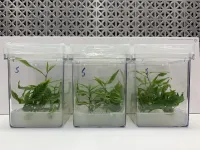(Press-News.org) Researchers have found that people who live beyond 105 years tend to have a unique genetic background that makes their bodies more efficient at repairing DNA, according to a study published today in eLife.
This is the first time that people with 'extreme longevity' have had their genomes decoded in such detail, providing clues as to why they live so long and manage to avoid age-related diseases.
"Aging is a common risk factor for several chronic diseases and conditions," explains Paolo Garagnani, Associate Professor at the Department of Experimental, Diagnostic and Specialty Medicine, University of Bologna, Italy, and a first author of the study. "We chose to study the genetics of a group of people who lived beyond 105 years old and compare them with a group of younger adults from the same area in Italy, as people in this younger age group tend to avoid many age-related diseases and therefore represent the best example of healthy aging."
Garagnani and colleagues, in collaboration with several research groups in Italy and a research team led by Patrick Descombes at Nestlé Research in Lausanne, Switzerland, recruited 81 semi-supercentenarians (those aged 105 years or older) and supercentenarians (those aged 110 years or older) from across the Italian peninsula. They compared these with 36 healthy people matched from the same region who were an average age of 68 years old.
They took blood samples from all the participants and conducted whole-genome sequencing to look for differences in the genes between the older and younger group. They then cross-checked their new results with genetic data from another previously published study which analysed 333 Italian people aged over 100 years old and 358 people aged around 60 years old.
They identified five common genetic changes that were more frequent in the 105+/110+ age groups, between two genes called COA1 and STK17A. When they cross-checked this against the published data, they found the same variants in the people aged over 100. Data acquired from computational analyses predicted that this genetic variability likely modulates the expression of three different genes.
The most frequently seen genetic changes were linked to increased activity of the STK17A gene in some tissues. This gene is involved in three areas important to the health of cells: coordinating the cell's response to DNA damage, encouraging damaged cells to undergo programmed cell death and managing the amount of dangerous reactive oxygen species within a cell. These are important processes involved in the initiation and growth of many diseases such as cancer.
The most frequent genetic changes are also linked to reduced activity of the COA1 gene in some tissues. This gene is known to be important for the proper crosstalk between the cell nucleus and mitochondria - the energy-production factories in our cells whose dysfunction is a key factor in aging.
Additionally, the same region of the genome is linked to an increased expression of BLVRA in some tissues - a gene that is important to the health of cells due to its role in eliminating dangerous reactive oxygen species.
"Previous studies showed that DNA repair is one of the mechanisms allowing an extended lifespan across species," says Cristina Giuliani, Senior Assistant Professor at the Laboratory of Molecular Anthropology, Department of Biological, Geological and Environmental Sciences, University of Bologna, and a senior author of the study. "We showed that this is true also within humans, and data suggest that the natural diversity in people reaching the last decades of life are, in part, linked to genetic variability that gives semi-supercentenarians the peculiar capability of efficiently managing cellular damage during their life course."
The team also measured the number of naturally occurring mutations that people in each age group had accumulated throughout their life. They found that people aged 105+ or 110+ had a much lower burden of mutations in six out of seven genes tested. These individuals appeared to avoid the age-related increase in disruptive mutations, and this may have contributed in protecting them against diseases such as heart disease.
"This study constitutes the first whole-genome sequencing of extreme longevity at high coverage that allowed us to look at both inherited and naturally occurring genetic changes in older people," says Massimo Delledonne, Full Professor at the University of Verona and a first author of the study.
"Our results suggest that DNA repair mechanisms and a low burden of mutations in specific genes are two central mechanisms that have protected people who have reached extreme longevity from age-related diseases," concludes senior author Claudio Franceschi, Professor Emeritus of Immunology at the University of Bologna.
INFORMATION:
This study will be published as part of 'Aging, Geroscience and Longevity: A Special Issue' from eLife. To view the Special Issue, see https://elifesciences.org/collections/6d673315/aging-geroscience-and-longevity-a-special-issue.
Media contact
Emily Packer, Media Relations Manager
eLife
e.packer@elifesciences.org
+44 (0)1223 855373
About eLife
eLife is a non-profit organisation created by funders and led by researchers. Our mission is to accelerate discovery by operating a platform for research communication that encourages and recognises the most responsible behaviours. We aim to publish work of the highest standards and importance in all areas of biology and medicine, including Genetics and Genomics, while exploring creative new ways to improve how research is assessed and published. eLife receives financial support and strategic guidance from the Howard Hughes Medical Institute, the Knut and Alice Wallenberg Foundation, the Max Planck Society and Wellcome. Learn more at https://elifesciences.org/about.
To read the latest Genetics and Genomics research published in eLife, visit https://elifesciences.org/subjects/genetics-genomics.
Studying protein changes in the kidneys as we age, as well as the transcription of genes into proteins, helps provide a full picture of the age-related processes that take place in these organs, says a study in mice published today in eLife.
Aging causes many changes in the body and in essential organs such as the kidneys, which function less efficiently later in life. Age-related changes in the kidneys have mostly been reported by looking at the transcription of genes - the process by which a segment of DNA is copied into RNA. The current study suggests that this approach, combined with studying changes in proteins, gives us a better understanding of age-related changes in the kidney and may point to new approaches for treating ...
TAMPA, Fla. (May 4, 2021) -- Repetitive transcranial magnetic stimulation, or rTMS, was FDA approved in 2008 as a safe and effective noninvasive treatment for severe depression resistant to antidepressant medications. A small coil positioned near the scalp generates repetitive, pulsed magnetic waves that pass through the skull and stimulate brain cells to relieve symptoms of depression. The procedure has few side effects and is typically prescribed as an alternative or supplemental therapy when multiple antidepressant medications and/or psychotherapy do not work.
Despite increased use ...
LONDON, ON - New findings from Ontario have shown that children born in Sarnia have a higher risk of developing asthma compared to neighbouring cities. A research team from Lawson Health Research Institute and Western University, using provincial data from ICES, found that higher air pollution exposure in the first year of life very likely contributed to this higher risk. Their results are published today in CMAJ Open.
Summary of study results:
-Children born in Sarnia in the 1990s and early 2000s were disproportionally at a higher risk of developing asthma in the first few years of life, compared to neighbouring cities.
-Air pollution exposure ...
Agência FAPESP – White-sand savannas are expanding in the heart of the Amazon as a result of recurring forest fires, according to a study published in the journal Ecosystems.
The study was supported by FAPESP, and conducted by Bernardo Monteiro Flores, currently a postdoctoral fellow in ecology at the Federal University of Santa Catarina (UFSC) in Brazil, and Milena Holmgren, a professor in the Department of Environmental Sciences at Wageningen University in the Netherlands.
“The edges of the Amazon Rainforest have long been considered the ...
FINDINGS
A new study by researchers at the UCLA Jonsson Comprehensive Cancer Center has identified a novel combination therapy to potentially help overcome resistance to immunotherapy in people diagnosed with advanced lung cancer. The combination approach uses immune checkpoint inhibitors with ATRA, a safe medication that is widely used to treat leukemia. The team found the combination therapy led to eradication of over 70% of tumors when tested in mice with LKB1-deficient lung cancer. It also generated durable tumor-specific immunity.
BACKGROUND
Immune checkpoint inhibitors have substantially ...
As nurseries and garden centers fill up with spring landscaping plants, home gardeners owe a lot to a technique called micropropagation, which has proven beneficial to many plants - perhaps soon to include cannabis, thanks to work by UConn researchers in the College of Agriculture, Health, and Natural Resources.
Micropropagation is a technique used for growing large quantities of new plants from fewer "parent" plants, yielding clones with the same, predictable qualities. The cannabis (Cannabis sativa) industry, however, has been largely left out of this beneficial technique, because this species of plant is extremely difficult to micropropagate.
Researchers from UConn - including Associate Professor Jessica Lubell-Brand, Ph.D. student Lauren Kurtz, and Professor Mark ...
May 4, 2021 - From the very beginning of the AIDS epidemic in 1981, nurses have been at the forefront of patient care, advocacy, and research. But even in the age of antiretroviral therapy and pre-exposure prophylaxis, many challenges remain in reducing the impact of HIV and AIDS, according to the special May/June issue of END ...
Relatives of the giant crocodile might have been kings of the waterways during the Cretaceous period, eating anything--including dinosaurs--that got a little too close to the water's edge, but the largest of these apex predators still started off small. Figuring out how these little crocs grew up in a world surrounded by giants is no small task. Now crocs fossils from Texas are shedding light on how these animals changed their diets as they grew, helping them find a place of their own in environments alongside their bigger, badder relatives.
According to the study, published by Cambridge University Press, the crocodiless in question are members of the Deltasuchus motherali and lived along the coastline of Texas 96 million years ...
Scientists have shed light on why some people who have a stroke do not also have abnormal heart rhythms, even though their hearts contain similar scar tissue.
Their results, published today in eLife, could help identify the best treatments for people who might be at risk of recurrent stroke, new heart disorders, or both.
Strokes are often caused by abnormal blood flow resulting from rapid, irregular beating in the upper chamber of the heart. This is also called atrial fibrillation (AFib). But some people have strokes that appear to have been caused by the heart, ...
Aachen, Germany and Hennigsdorf/Berlin, Germany, May 4, 2021 - German University Hospital Uniklinik RWTH Aachen ("Uniklinik RWTH Aachen") and diagnostics company SphingoTec GmbH ("SphingoTec") today announced that the endothelial function biomarker bio-ADM aids in the early risk stratification and management of patients suffering from severe COVID-19, in need for escalated intensive care treatment (1). A team lead by the clinical researchers at Uniklinik RWTH Aachen has shown that high bio-ADM levels indicate the severity of the acute respiratory distress ...


